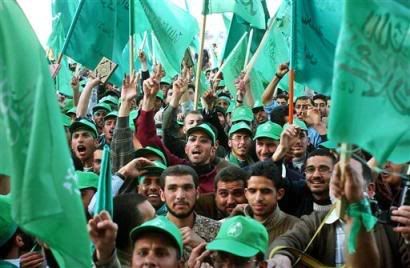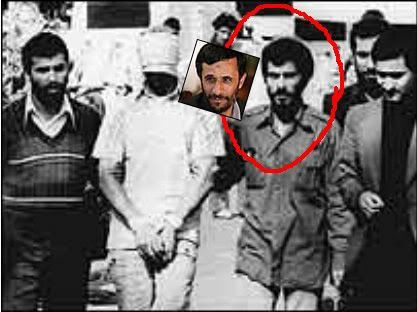By Joel Mowbray FrontPageMagazine.com
March 27, 2007
 How could the U.S. government be funding Hamas’s university in Gaza? It’s the question that has been asked often since my front-page story in the Washington Times earlier this month, from Capitol Hill to the State Department’s daily press briefing.
How could the U.S. government be funding Hamas’s university in Gaza? It’s the question that has been asked often since my front-page story in the Washington Times earlier this month, from Capitol Hill to the State Department’s daily press briefing.
No good answer was provided—but in fairness, no good answer exists for supporting a college controlled by Hamas. The alternatives, though, aren’t much better. The sad reality of Palestinian society is that almost any university the U.S. might choose to support at a minimum has student chapters of terrorist organizations on campus.
Whereas Americans have College Republicans and College Democrats, Palestinians have College Hamas and College Islamic Jihad.
Even Al Quds University—embraced as the bastion of moderation by the U.S. Agency for International Development (USAID)—engaged in a weeklong celebration this January of the terrorist credited with developing the first suicide belts more than a decade ago.
Given how much leverage the U.S. has—just through money alone—officials could have demanded that at least some of the support or glorification of terrorism be put to an end. There’s no indication, though, that any such pressure was applied.
Rather, it appears that USAID, most likely with guidance from State, decided to fund Palestinian universities with troubling terrorism ties—including the Hamas-controlled Islamic University—and simply hope that no one would catch on. That might have been the case—if not for the Palestinian Media Watch (PMW), which keeps a watchful eye on everything from school textbooks to television shows and newspaper articles.
PMW has documented, mostly through local and school newspaper articles, that student chapters of terrorist organizations are the most potent political forces on the vast majority of Palestinian campuses. And it was PMW Director Itamar Marcus who tipped off this journalist that USAID’s support of Islamic University needed to be investigated. Marcus provided a 2006 article from Hamas’s newspaper al-Risala proclaiming that 16 Islamic University teachers had just been elected as Hamas members of the Palestinian legislature.
It took several weeks to compile overwhelming evidence of Hamas control of Islamic University, but it was all attainable trough open sources—and it is precisely the kind of information that should have been uncovered in the “careful vetting process” State insists occurred before the school received assistance.
Thus it was all the more vexing that the official line, established by State Department spokesman Sean McCormack the day the article ran, is that Hamas University is “independent.” No proof was offered to support this contention, nor was any argument advanced challenging the evidence in the article pointing to Hamas’s firm control of Islamic University:
- Hamas founder Sheikh Ahmed Yassin founded the school in 1978.
- Sheikh Yassin, former Hamas leader Abdel Aziz Rantisi, and current Hamas leader Ismail Haniyeh have all used the school as a base.
- Haniyeh sits on the school’s board of trustees.
- The school’s 16 parliamentarians account for more than one-fifth of all Hamas legislators.
- Hamas used the campus to host a two-day conference in 2005 on the “martyrdom” of Sheikh Yassin.
- Students gave 78% of their student council votes in 2005 to the Hamas-affiliated party.
Congress didn’t buy State’s spin. House Foreign Affairs chairman Rep. Tom Lantos (D-CA) unleashed a blistering attack to open his committee’s USAID hearing, held three days after the article ran. Making sure his words would not be misinterpreted, Lantos told USAID Director Ambassador Randall Tobias, “Providing U.S. assistance to a terrorist-controlled university in Gaza was out of the question and, in fact, violates U.S. law.” He added, “This outrageous support for terrorism must and will end.”
This isn’t the first time Congress has told State and USAID that funding in the West Bank and Gaza needed serious reform. Following publication of a Palestinian Media Watch report in June 2004 about USAID funding entities engaged in the support, advocacy, or glorification of terrorism, Congress moved to restrict aid to institutions or individuals “involved in or advocating terrorist activity.”
Within months of the law being changed, USAID issued its next batch of assistance to the Hamas-controlled Islamic University—exactly as it had before Congress acted. It’s not clear, in fact, that USAID did anything of substance to be in compliance with the clear intent of Congress.
When asked by this journalist about its funding decisions in the West Bank and Gaza, USAID pointed to $2.3 million in assistance provided to Al Quds University. Undermining USAID’s argument that funding the school is wise policy, however, was the weeklong celebration this January of Yahya Ayyash, the Hamas leader known as “the shahid [martyr] engineer.” He is credited with creating the first suicide belts in the mid-1990s and training the next generation of suicide bomb makers.
The school’s celebration of a leading terrorist actually seems to be in line with the beliefs of its leader. The president of Al-Quds University President, Sari Nusseibeh, is widely considered a leading Palestinian moderate—USAID praised him as “one such prominent and respected figure”—yet he, too, celebrates the glories of terrorists.
In an appearance on Al-Jazeera in 2002 with Hamas political bureau chief Khalid Mashaal and the mother of a suicide bomber, Nusseibeh had this to say of the woman who proudly raised a terrorist: “When I hear the words of Umm Nidal, I recall the [Koranic] verse stating that ‘Paradise lies under the feet of mothers.’ All respect is due to this mother; it is due to every Palestinian mother and every female Palestinian who is a Jihad fighter on this land.” (Transcript provided by PMW.)
As Palestinian colleges go, Al-Quds University might well be quite moderate—but that’s the problem. If terrorists are hailed as heroes at the moderate schools, imagine what happens at the more radical ones.
If Congress successfully closes all loopholes this time around, maybe we won’t have to.
Read more...
 President Hugo Chavez ordered Venezuela's bank deposit protection fund to transfer its assets "to the poor," the latest move threatening to undermine one of the country's autonomous financial institutions.
President Hugo Chavez ordered Venezuela's bank deposit protection fund to transfer its assets "to the poor," the latest move threatening to undermine one of the country's autonomous financial institutions.

 How could the U.S. government be funding Hamas’s university in Gaza? It’s the question that has been asked often since my
How could the U.S. government be funding Hamas’s university in Gaza? It’s the question that has been asked often since my  By
By 







